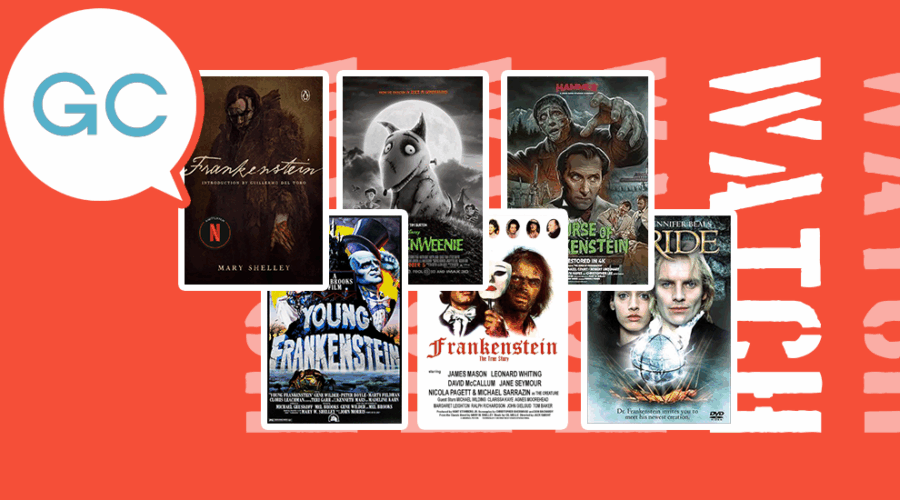Centuries pass, faces change, screens multiply, but Frankenstein remains; breathing between lightning bolts and questions. Now, the monster comes back to life once more with Guillermo del Toro, who releases his cinematic adaptation of Mary Shelley’s classic on Netflix this November.
Since young Mary Shelley published her novel, Frankenstein; or, The Modern Prometheus has never stopped evolving. Film, theater, television, comics, and video games have all reinterpreted the story of the scientist who dares to challenge the limits of creation.
Although the eras and styles may change, at the heart of every version beats the same question: what makes us human?
From the laboratory to Hollywood
Shelley’s creature reached the screen when ‘the seventh art’ was still learning to crawl. In 1910, Edison Studios produced the first Frankenstein short film, a 15-minute silent piece now regarded as the seed of the cinematic myth. But it was in 1931 that the monster became immortal thanks to James Whale and Boris Karloff.
Universal Pictures’ film not only defined the monster’s look —broad forehead, neck bolts, awkward gait— but also his tragic dimension: a being that never asked to be created, condemned to be feared.
The success was such that Universal built an entire saga. Bride of Frankenstein (1935), also directed by Whale, elevated the myth to another level: a blend of horror and dark humor, featuring the unforgettable bride played by Elsa Lanchester, who appears for just a few minutes yet became a cultural icon. Then came Son of Frankenstein (1939), House of Frankenstein (1944), and other productions that expanded the “monster-verse” of the 1930s and ’40s.
Decades later, Britain’s Hammer Films resurrected the monster with a different tone: bloodier, more gothic, more human. In The Curse of Frankenstein (1957), Peter Cushing portrayed a far more ambitious (and crueler) Victor Frankenstein, while Christopher Lee played a brutal yet pitiful creature.
That saga, which continued through the 1960s, restored the character’s visual and moral power: science without a soul breeds monsters —and sometimes dresses them in lab coats.
From romantic drama to satire
As time went on, adaptations began to mirror the tensions of each era. In the 1970s, British television surprised audiences with Frankenstein: The True Story (1973), a miniseries ahead of its time that portrayed the creature as sensitive and vulnerable, an emotional mirror of his own creator.
In the 1980s and ’90s, the myth grew more introspective. The Bride (1985), starring Sting and Jennifer Beals, explored loneliness and difference from a female perspective. But it was Kenneth Branagh, with Mary Shelley’s Frankenstein (1994), who brought the story back to its literary roots. With Robert De Niro as the creature and a lavish, operatic production, Branagh presented a passionate and visually overwhelming Frankenstein. The result divided critics but reclaimed the original novel as a philosophical drama rather than mere horror.
The myth has even found room for parody and humor. The most brilliant example is Mel Brooks’s Young Frankenstein (1974), starring Gene Wilder. The film perfectly mimics the 1930s style while deconstructing it with wit.
From Shelley to Netflix: the creature mutates again
In the 21st century, Frankenstein found new ways to exist. On television, the series Penny Dreadful (2014–2016) placed him in a shared gothic universe alongside Dracula and Dorian Gray. There, Dr. Victor Frankenstein is a tormented young man, and his creature a sensitive soul, a poetry reader wounded by rejection — one of the most literary and faithful versions to Shelley’s tone.
Another notable interpretation came with The Frankenstein Chronicles (2015–2017), starring Sean Bean, which mixed the monster’s mythology with a dark, corrupt, almost detective-like London. On film, Victor Frankenstein (2015) tried to modernize the story through the friendship between the doctor and his assistant Igor, played by James McAvoy and Daniel Radcliffe.
Even animation has claimed its place. Tim Burton’s Frankenweenie (2012) paid tribute to the myth with tenderness and a stop-motion aesthetic. Its message closer to Shelley than it seems: loss, creation, and the impossibility of controlling what we love.
Guillermo del Toro: the monster comes home
And now, as if the circle were closing, Guillermo del Toro has crafted his own version for Netflix — a long-dreamed project starring Oscar Isaac as Victor Frankenstein, Andrew Garfield as the creature, and Mia Goth.
The Mexican director, forever obsessed with monsters, offers a vision more emotional than terrifying. Del Toro doesn’t seek to resurrect the creature but to remind us that it never died; it still lives among our laboratories, algorithms, and mirrors.
Frankenstein was never just a horror story. It was — and remains — a mirror. Mary Shelley wrote about the power and peril of creation without love or responsibility.
In every era, her creature rises again with a new face; a metaphor for scientific fear, isolation, moral punishment, or technological excess.
And perhaps that’s why, more than two centuries later, we keep returning to it.

